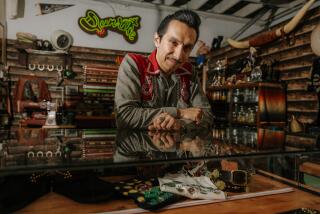Q&A: To corset or not to corset? For ‘Colette,’ the answer was simple — and emphatic
Hungarian fashion designer Andrea Flesch’s costume designs for the enchanting “Colette” thoroughly embody the famed French author and raconteuse Sidonie-Gabrielle Colette’s spirit as an early 20th century gender rebel and fashion icon. The intricate detailing and authentic reproductions of the literary iconoclast’s fashions showcase her masculine-tinged wardrobe perfectly.
“This is the first time I’ve done this time period and it’s so lovely to have it be with Colette,” says Flesch enthusiastically from Europe. “It’s always the best when you do a period for the first time, the energy is high. The ’40s I’ve done a thousand times and if you woke me up in the middle of the night I could still tell you everything about it. But the first time is always fresh.
“It was really one of the best experiences of my life and I loved it with all my heart,” Flesch adds of working on the Wash Westmoreland film. “Colette was such an original woman, it’s amazing her life story wasn’t seized upon for the screen long ago.”
Certain cultural icons have a personal style that seems at once both fully realized yet in reality is always evolving: Think of Elvis, Bowie, Madonna. Colette is in this category. Was that challenging to capture on film?
Yes, it was a long arc that we pulled together. She wasn’t as much about fashion per se as following that inner voice of her own internal improvement, her private path and opening to finding herself. She was very much one of those people. They don’t look to others necessarily to tell them things and how to look, they look inside. As she matured, her clothes changed with her.
I understand early on the decision was made for Keira Knightley (as Colette) not to wear a corset. How did that decision come about? Colette, herself, would have worn one, yes?
Yes, there are even some well-known photos of pulling a corset on her! It was Wash’s idea and I think also Keira. Keira was very decided that she didn’t need or want a corset. So it was not my idea but I think it was a great idea. It really changed everything.
I remember when we were in London and getting everything pulled together and people were looking at me how “it’s not right” that she’s not wearing a corset. But it was a really great idea. Keira was, from the beginning, very prepared and solid in her vision of Colette — she had a very strong feeling and you can see through the whole film it makes a very big difference to her character not to be bound up by a corset, for everything she means.
With that corset-free image, Colette was seemingly a forerunner of Coco Chanel who arrived on the scene relatively soon after?
Absolutely. This was my vision. They were similar and familiar to me, both Colette and Coco Chanel. Also, Coco Chanel’s favorite writer was Colette, so later on they knew each other in real life. But I feel the same when I think about Coco Chanel or Colette, it’s something about freedom. I have to say Colette wasn’t so aware of fashion like Chanel, but the inner thing was very similar.
How did you arrive at the lovely but subdued color palette of ivory, gray, brown, and black and white? I’d have thought Paris fashion of the time was filled with bright colors.
It’s interesting because in the beginning before we started when I was making moods for Wash, I had everything more colorful. Yet when I got in the midst of the work I really felt it had to be more black and white. Colette’s personality is so clean and so simple and so sensitive in a profound way, and so I didn’t want to have the clothes moving around and distracting from her.
I wanted to keep her personality center stage. For me she’s a very elegant person, and black and white is the most elegant thing in costume. So, suddenly, I saw that no other colors could get in. I know in real life at that time things could be fussy and overwhelming and colorful but I wanted to make things a bit plain, not exaggerated, to keep it simple.
Even when Keira wore very feminine clothes — I’m thinking of that beautiful ivory blouse she wore repeatedly with the ruffles and high collar; there was always a masculine twist to it. Were there tricks you used for that?
That was the goal, yes. I used skinny ties a lot and on that I was inspired by Colette herself. She wore them in real life. A few women of the time wore them, but not many. It was considered more liberated and modern. For her, it was a statement.
How involved was Keira in her costumes and fittings?
It was amazing with Keira. It’s OK when a costume is great but when someone puts it on and wears and feels it, that’s the amazing moment for me. It was good that she didn’t just have fittings and it’s “OK,” but she had lots of ideas; we collaborated and we always agreed in the end. She always knew the correct thing to do for her character and the film, her instincts are excellent. I think we put together around 50 costumes for her.
FULL COVERAGE: Get the latest on awards season from The Envelope »
More to Read
From the Oscars to the Emmys.
Get the Envelope newsletter for exclusive awards season coverage, behind-the-scenes stories from the Envelope podcast and columnist Glenn Whipp’s must-read analysis.
You may occasionally receive promotional content from the Los Angeles Times.










